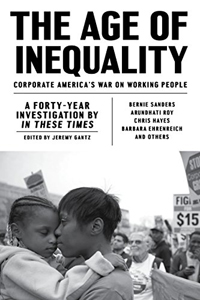The Age of Inequality: Corporate America’s War on Working People
Edited by Jeremy Gantz
Reviewed by Mark D. Walker
 A culmination of forty years of reporting by investigative reporters and progressive thinkers focuses on one of the key issues of our time, a steady movement towards an oligarchy in which ever more resources are being concentrated in an every smaller segment of our population. The richest 1 percent of Americans now own more wealth than the bottom 90%, while the country’s median household income is less today than it was in 1989. The great struggles of U.S. history, from the Civil War to the civil rights movement, have at their core been fights over the gap between the promise of equality opportunity and reality.
A culmination of forty years of reporting by investigative reporters and progressive thinkers focuses on one of the key issues of our time, a steady movement towards an oligarchy in which ever more resources are being concentrated in an every smaller segment of our population. The richest 1 percent of Americans now own more wealth than the bottom 90%, while the country’s median household income is less today than it was in 1989. The great struggles of U.S. history, from the Civil War to the civil rights movement, have at their core been fights over the gap between the promise of equality opportunity and reality.
The In these Times articles are not research but show why the country became so unequal so quickly—and how people pushed back against this reality. The first part of the book examines the causes and effects of growing inequality. Part Two focuses on those who pushed for change. Intensifying globalization is an important theme as it has both undermined and heightened the power of borders, sparking transnational solidarity and protest. If reversing inequality is one of the great challenges of our time, then the great mystery which is also explore in these articles is why so many people for so long seemed to accept a new reality that demands more work for less money.
The articles reveal a number of important trends in the labor market today such as the growing freedom Multinational corporations have to search abroad for the cheapest wages which explains why the country has lost a net 5 million manufacturing jobs between 2000 and 2014. In the introduction of the section, “Welcome to the Precariat” by Rebecca Burns, the reader learns that the number of temporary workers hit an all-time high of 2.9 million in 2015 leading to the emergence of a new class of “permatemps” dominated by the most vulnerable workers: African Americans, Latinos and women are all overrepresented. This change obviously poses serious challenges for unions and organizers.
Another group being negatively impacted by changes in the labor market are Adjunct professors according to Rebecca Burns in her article, “The Adjunct’s Lament.” “Employers have long treated immigrant workers as disposable. A combination of precarious working conditions and exclusion from legal protections have according to Ms. Burns led to “more American workers than ever knowing how they feel.”
Some of the articles reflect issues which will cause growing problems which groups such as illegal immigrants like Dennis Bernstein and Connie Blitt’s article, “Central American Refugees for Profit” written in 1986 where the Corrections Corporation of American teams up with the U.S. Government to create a “sparkling new, state-of-the art prison for profit. One Laredo attorney and refugee advocate considers that the facility “threatens to end children for many refugee youth” and that “boredom created by limited recreational or educational programs at the institution plays right on the hands of another profit-stretching device employed by CCA, the use of “volunteer” labor.”
Another timely article is David Bacon’s, “All Over the World Migrants Demand the Right to Stay at Home”, which points out that the government spends more today on border and immigration enforcement than on all other federal law enforcement agencies combined. And yet many countries are becoming more dependent on their “remittances” which in 2012 worldwide reached $401 billion, over 5 percent higher than the previous year. But most importantly, most migration “is fueled by the need to survive. The alternative according to the US-Mexico Binational Front on Indigenous Organizations is the “right to stay home”—to promote economic development that can make migration a voluntary option” not a necessity.
The challenge for the future is articulated by New York Times columnist Nicolas Kristof who concluded, “What American, however well-meaning, is astonishingly oblivious of pervasive inequality.” Something this publication and some of its impressive contributors like Ralph Nader, Michelle Chen and Noam Chomsky are trying to change. In order to change the current political and economic trends, we must begin with an understanding of how we ended up here and this series of articles is a good place to start.
Product details
⦁ File Size: 642 KB
⦁ Print Length: 273 pages
⦁ Page Numbers Source ISBN: 1786631148
⦁ Publisher: Verso (April 18, 2017)
⦁ Publication Date: April 18, 2017
⦁ Sold by: Penguin Random House Publisher Services
⦁ Language: English
⦁ ASIN: B01FBZZG3E
⦁ Text-to-Speech: ⦁ Enabled
⦁ X-Ray:Enabled
⦁ Word Wise: Enabled
⦁ Lending: Not Enabled
⦁ Screen Reader: ⦁ Supported
⦁ Enhanced Typesetting: ⦁ Enabled
⦁ Amazon Best Sellers Rank: #331,743 Paid in Kindle Store (⦁ See Top 100 Paid in Kindle Store)
⦁ #126 in ⦁ Kindle Store > ⦁ Kindle eBooks > ⦁ Nonfiction > ⦁ Politics ⦁ &⦁ Social Sciences > ⦁ Social Sciences > ⦁ Poverty
⦁ #155 in ⦁ Kindle Store > ⦁ Kindle eBooks > ⦁ Reference > ⦁ Writing, Research ⦁ &⦁ Publishing Guides > ⦁ Journalism
⦁ #187 in ⦁ Kindle Store > ⦁ Kindle eBooks > ⦁ Nonfiction > ⦁ Politics ⦁ &⦁ Social Sciences > ⦁ Social Sciences > ⦁ Sociology > ⦁ Social Classes ⦁ &⦁ Economic Disparity